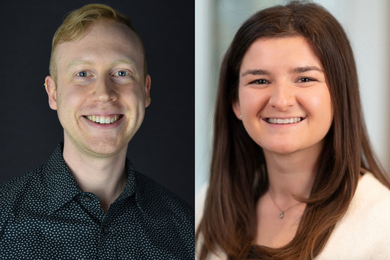In his native Chile almost 40 years go, a young Eduardo Kausel saw first-hand what a major earthquake can do to buildings. That experience was responsible, in part, for the direction of his career. Now a professor in the Department of Civil and Environmental Engineering (CEE), his current research projects include simulating the effects of seismic motions on large structures, and applying seismology to the inspection of bridges.
'SHAKING TABLE'
Professor Kausel, Professor M. Nafi Toksoz of the Department of Earth, Atmospheric and Planetary Sciences, and Research Scientist Emmanouil Chaniotakis of the Plasma Science and Fusion Center are studying how structures respond to earthquakes, how the seismic waves travel underneath the foundations, and how they interact with and affect structures. "Once structures begin deforming by substantial amounts, our ability to predict how they behave deteriorates very quickly," Professor Kausel said.
The MIT project, sponsored by the Idaho National Engineering Laboratory, is actually a feasibility study for building a very large shaking table measuring 30 meters (100 feet) on a side. The table would be able to support a hefty model structure and also simulate waves moving underneath the structure.
Companies and laboratories are testing increasingly large structures. At Takenaka Co. in Japan, Professor Kausel experienced vibration tests on a six-story building. "I was on the top floor. They put the shaker in motion, and it really felt like an earthquake. Of course, it was a controlled experiment, but you could see the buildings nearby moving past the windows.
"We can also test scale models, but they're only accurate for small to moderate motions. Once the model building begins cracking and bending like a paper clip, it no longer quite behaves like a real structure, because it's nearly impossible to scale down all relevant parameters such as material properties, dynamic stresses or weight."
TESTING BRIDGE DECKS
In another project that applies concepts from seismology, Professor Kausel and colleagues from a local company, NDT (non-destructive testing) Engineering, are developing an automated diagnostic testing device for determining if a bridge needs to be repaired.
"Our emphasis is acoustic," Professor Kausel said. "If you buy china, you tap it and try to decide on the basis of the sound whether it is in good condition." In a less delicate fashion, the researchers strike the bridge with a pellet shot out of an air gun, and transducers pick up the vibrations transmitted by the concrete surface.
The device being developed by Professor Kausel and NDT colleagues Richard Holt and Paul Fisk along with CEE graduate student David Peralta would analyze the resulting acoustic signatures to see whether the bridge needs repairs. The team has produced a prototype, but it is not yet fully operational.
An estimated 200,000 bridges in the United States are deemed in need of repair. Currently, making the decision about repairs involves "a seismologist or a trained reader who examines a stack of hundreds of signatures," Professor Kausel said. "By looking at patterns and applying certain concepts from seismology, the analyst can determine if something is wrong. But it's extremely labor-intensive and tedious, since a long bridge will result in thousands of recordings."
To automate this process, "we're trying to reproduce in the computer what the seismologist does," he said. "Once it's fully automatic, ideally the computer would be able to determine not only if the bridge needs repairs, but also where the defects lie. Basically, we would like to isolate the bad areas and get an initial assessment of the bridge condition."
Ultimately, the successful bridge test will combine acoustic methods with radar and other techniques such as infrared thermography, because every method has advantages and disadvantages, Professor Kausel explained. For example, he said, "radar is unable to detect a void, while acoustic waves can detect a void because they are reflected as soon as they hit the void. If the void is filled with water, however, the acoustic wave will go right through, while the radar wave will be reflected. Using both techniques, we will have a much better picture than if we use one in isolation."
The work is funded by the Massachusetts Highway Department.
(This article was adapted from a piece that originally appeared in the Civil and Environmental Engineering at MIT newsletter).
A version of this article appeared in MIT Tech Talk on March 12, 1997.





